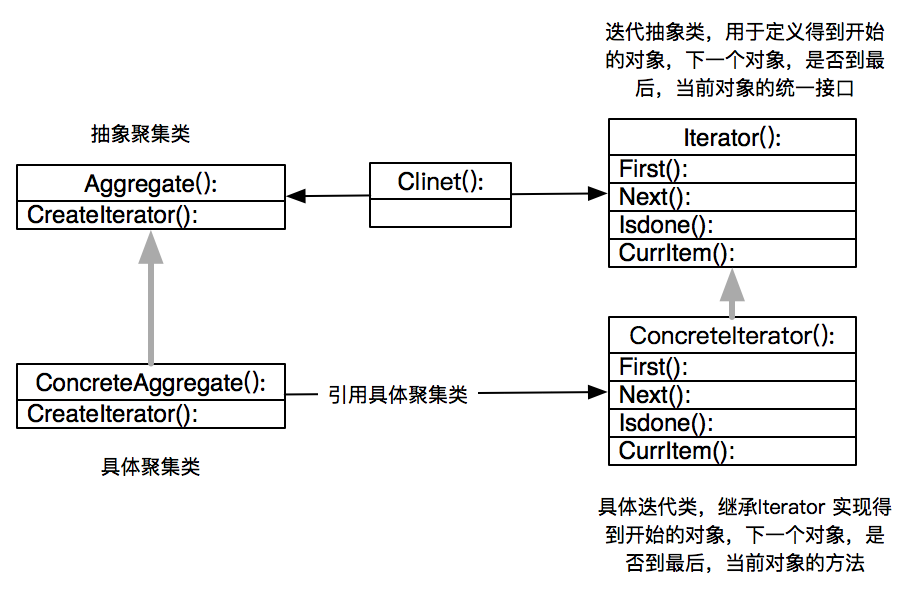迭代器模式(Iterator Pattern):提供方法顺序访问一个聚合对象中各元素,而又不暴露该对象的内部表示.
下面是一个迭代器模式的demo:
1 #!/usr/bin/env python 2 # -*- coding:utf-8 -*- 3 4 __author__ = 'Andy' 5 """ 6 大话设计模式 7 设计模式——迭代器模式 8 迭代器模式(Iterator Pattern):提供方法顺序访问一个聚合对象中各元素,而又不暴露该对象的内部表示. 9 """ 10 #迭代器抽象类 11 class Iterator(object): 12 def First(self): 13 pass 14 15 def Next(self): 16 pass 17 18 def Isdone(self): 19 pass 20 21 def CurrItem(self): 22 pass 23 24 #聚集抽象类 25 class Aggregate(object): 26 27 def CreateIterator(self): 28 pass 29 30 #具体迭代器类 31 class ConcreteIterator(Iterator): 32 33 def __init__(self, aggregate): 34 self.aggregate = aggregate 35 self.curr = 0 36 37 def First(self): 38 return self.aggregate[0] 39 40 def Next(self): 41 ret = None 42 self.curr += 1 43 if self.curr < len(self.aggregate): 44 ret = self.aggregate[self.curr] 45 return ret 46 47 def Isdone(self): 48 return True if self.curr+1 >= len(self.aggregate) else False 49 50 def CurrItem(self): 51 return self.aggregate[self.curr] 52 53 #具体聚集类 54 class ConcreteAggregate(Aggregate): 55 56 def __init__(self): 57 self.ilist = [] 58 59 def CreateIterator(self): 60 return ConcreteIterator(self) 61 62 class ConcreteIteratorDesc(Iterator): 63 def __init__(self, aggregate): 64 self.aggregate = aggregate 65 self.curr = len(aggregate)-1 66 67 def First(self): 68 return self.aggregate[-1] 69 70 def Next(self): 71 ret = None 72 self.curr -= 1 73 if self.curr >= 0: 74 ret = self.aggregate[self.curr] 75 return ret 76 77 def Isdone(self): 78 return True if self.curr-1<0 else False 79 80 def CurrItem(self): 81 return self.aggregate[self.curr] 82 83 if __name__=="__main__": 84 ca = ConcreteAggregate() 85 ca.ilist.append("大鸟") 86 ca.ilist.append("小菜") 87 ca.ilist.append("老外") 88 ca.ilist.append("小偷") 89 90 itor = ConcreteIterator(ca.ilist) 91 print itor.First() 92 while not itor.Isdone(): 93 print itor.Next() 94 print "————倒序————" 95 itordesc = ConcreteIteratorDesc(ca.ilist) 96 print itordesc.First() 97 while not itordesc.Isdone(): 98 print itordesc.Next()
上面类的设计如下图:

当需要对聚集有多种方式遍历时,可以考虑使用迭代器模式
迭代器模式分离了集合的遍历行为,抽象出一个迭代器类来负责,这样既可以做到不暴露集合内部结构,又可以让外部代码透明的访问集合内部的数据
作者:Andy
出处:http://www.cnblogs.com/onepiece-andy/
本文版权归作者和博客园共有,欢迎转载,但未经作者同意必须在文章页面明显位置给出原文连接,否则保留追究法律责任的权利。